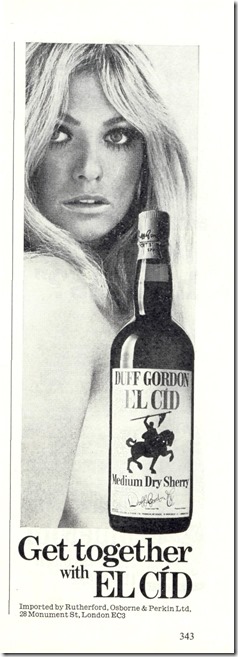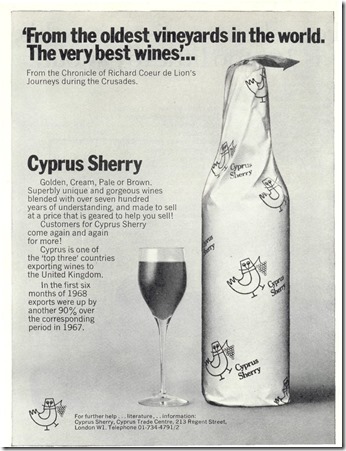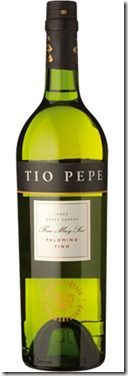In Britain, sherry may be a minority tipple, but it is a large enough one for a good range to be stocked in wine stores and supermarkets, whereas in Cyprus it is not easy to find and the range available is quite limited. The demise of what used to be called Cyprus sherry also diminished the market. I find it a drink well worth exploring.
Perhaps it is because it was the only alcoholic drink kept in my parents’ home, but I have always had a soft spot for Sherry. In those far off days, it only came from Spain, and had some sweetness about it, unlike the very dry ones I came to enjoy in adult life. We always had a glass at Christmas and I remember the first sips allowed me when I was five, and loving it.
It was sherry that first got me into the wine business. I was 29 and just starting to work for myself as a PR consultant. Because I had been in the film business, an early client was the movie mogul Samuel Bronston whose epic film “El Cid” I was to promote in the UK. A publicity link with the then famous Sherry “El Cid” was a natural, and this introduced me to many wine people in London. More of that another time!
Sherry is a fortified wine – that is to say it is quite a light base wine (in most cases of dry sherries this is likely to be made from the Palomino grape), to which grape alcohol is added to produce a wine of some substance. Wine was originally treated in this way, by the Spanish and Portuguese to stabilise it for the long sea journeys amid changing temperatures to their colonies in Africa, India and the West Indies, for the delectation of their nationals living there. Sherry, and its other famous cousins, Port, Madeira and Malaga can be made to be very dry (adding alcohol is one method of stopping fermentation) through medium-sweet to very sweet (e.g. Malmsey).
All fortified wines have a long history, very much enhanced by the involvement of the British, sometimes in matters of war, but more generally as merchants, investors, growers and winemakers. Sherry or “Sac” was the great drink of England for centuries.
How it used to be…. Cyprus Sherry advertising in 1968.
Couple the word “Sherry” and “E.U.” together in any conversation with a Cyprus wine old-timer and they shudder. Joining the EU was the death knell for the very successful bulk-wine business enjoyed by Limassol’s Big Four wineries – making and exporting “Cyprus Sherry”. This was not properly made in the Spanish manner, with the exception of the wonderful KEO “Fino”, it was simply wine with a spirit added and matured outdoors in barrels. It was also cheap and very drinkable. One such called “Mosaic” was my pre-dinner tipple for years.
KEO Fino was the brilliant exception to the Cyprus sherry “method”, and survived in to the EU era, just. But the faint-hearted management of the time couldn’t see a future for this beautiful wine, actually made in Limassol in a real Spanish-style Bodega, and dispensed with it, along with the Bodega, which would have had a Preservation Order slapped on it in many other countries. A crime. I hear a reader asking: “And what is Fino?” It is the driest of sherries and for me, the delight of them.
In more recent times, before we all gave attention to the amount of liqueur we consumed (and before the breathalyser and dink-driving laws), it was very popular to precede a meal with a glass or two of sherry, dry Port or Madeira, and at some stage after the main course, with cheese, fruit or dessert to have a dessert wine. But the custom died away and fortified wines suffered something of a decline. Pity. I think an ideal meal starts with a glass of Sherry or Sercial Madeira, has a glass of dry white with the fish, a couple of glasses of red with the meat and finishes with a Port with the Stilton, or a sweet Madeira with the pudding (Ah, those were the days).
Sherry used to be considered high in alcohol (a good Fino comes in at around 15% and a sweeter one up to 17.5%), but today the fashion for big, powerful table wines of 14 – 16% in alcohol puts it into the “acceptable” frame. I abhor this trend, actually. My preferred alcohol level for table wines is 12 – 13%.
During my life in Cyprus, and mourning the passing of my favourite KEO Fino, I searched for a Spanish Fino to take its place in my wine cave. I found real dry sherry from Jerez in Spain hard to come by. However, one of the best and one of four marked at more than 90 points by Spain’s leading wine authority is available but you may have to buy it from the importer.
Tio Pepe is possibly the most famous Fino in the world. It is very dry, with noticeable but gentle acidity and substance on the palate and finish. It is an ideal drink before lunch, along with some stuffed green olives, salted nuts and perhaps a slice of salami. It is also one of the few wines that can accompany soup and I recommend it with fish and sea food bisques and the local Trachanas. Here, not only the very dry Fino does well, but the slightly sweet, nutty Amontillado, too.
Dry and medium dry Sherry comes into its own with the Spanish Mezedes, known as Tapas. These range from tiny plates served in bars with a drink, to a full Meze Table.
I remember my first encounter with them very well – as a young visitor to Madrid. Friends called for me around 8.00 in the evening and took me to “The Street of the Tapas Bars”, near the Plaza Mayor. There were several dozen little places, each one serving an anonymous wine in a stemless glass along with the Tapas of the House. A prawn in pepper sauce, stuffed olives, an octopus ring, a wild mushroom, fried ham, cheese, baby omelette… and so forth. After more than an hour and a half of sampling a dozen or so, I was, firstly, full, and secondly decidedly tipsy. It was getting on for 10 o’clock. “Now we go for dinner”, my friends said. After that: “Now we go to a
Flamenco place”. I got to bed around 6.00 thanking Providence that it was now the weekend.
Despite this, I have always loved Tapas. And there are wonderful recipes to make at home.
Buying Sherry in Cyprus…
Very few importers bother with it. The better hotels and restaurants may offer you a glass. Importers Ghalanos offer three. The dry Tio Pepe (Eur 15.47 per bottle); medium-dry Sandeman’s (Eur 8.92) and sweet Croft Pale Cream (Eur 14.16)
For anyone who hasn’t tried Sherry with a meal of mixed small plates or with soup, I recommend it. I don’t have to tell British readers where to buy it – the nearest supermarket is bound to have some.



